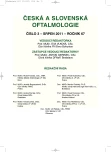-
Medical journals
- Career
Lyell’s Disease – a Case Report
Authors: R. Kiszová 1; D. Cholevík 1; J. Timkovič 1; T. Zaoral 2; I. Zámečníková 3
Authors‘ workplace: Oční klinika, FN Ostrava, přednosta MUDr. Petr Mašek, CSc. 1; Klinika dětského lékařství, FN Ostrava, přednosta doc. MUDr. Michal Hladík, Ph. D. 2; Popáleninové centrum, FN Ostrava, primář MUDr. Iva Zámečníková 3
Published in: Čes. a slov. Oftal., 67, 2011, No. 3, p. 104-106
Category: Case Report
Overview
Lyell’s disease is a rare, life-threatening, acute dermatologic disease. The mucous membranes are also often involved. Nearly all cases are induced by medications. There is currently no specific treatment and interdisciplinary cooperation is very important. The authors present a case report of a 15 year old boy with the ocular manifestations of Lyell’s disease, triggered by lamotrigine. He was admitted to the burn unit with involvement of 85% of his body surface area. Ocular manifestations documented during hospitalization were classified as mild (lid edema, conjunctival injection) and later severe (multiple symblepharons). The patient was treated with antibiotic eyedrops/ointment, corticosteroid eyedrops/ointment, topical lubricants and a glass rod was used to lyse the symblepharons. At 23 months of follow-up our patient had a symblepharon which blocked the superior and inferior punctum in both eyes, without conjunctival fornix foreshortening or corneal abnormalities, minimal ocular discomfort.
Key words:
Lyell’s disease, toxic epidermal necrolysis, symblepharon
Sources
1. Becker, D.S.: Toxic epidermal necrolysis. Lancet, 1998; 351 : 1417–1420.
2. Halebian, P.H., Corder, V.J., Madden, M.R. et al.: Improved burn center survival of patients with toxic epidermal necrolysis managed without corticosteroids. Ann Surg., 1986; 204(5): 503–512.
3. Hanken, I., Schimmer, M., Sander, C.A.: Basic measures and systemic medical treatment of patients with toxic epidermal necrolysis. J Dtsch Dermatol Ges., 2010; 8(5): 341–346.
4. Chang, Y.S., Huang, F.C., Tseng, S.H. et al.: Erythema multiforme, Stevens–Johnson syndrome and toxic epidermal necrolysis: acute ocular manifestations, causes and management. Cornea, 2007; 26 : 123–129.
5. Lissia, M., Mulas, P., Bulla, A. et al.: Toxic epidermal necrolysis (Lyell’s disease). Burns, 2010; 36 : 152–163.
6. Lyell, A.: Toxic epidermal necrolysis: an eruption resembling scalding of the skin. Br J Dermatol, 1956; 68 (11): 355–361.
7. Paquet, P., Pierard, G.E., Quatresooz, P.: Novel treatments for drug-induced toxic epidermal necrolysis (Lyellęs syndrome). Int Arch Allergy Immunol, 2005; 136 (3): 205–216.
8. Power, W.J., Ghoraishi, M., Merayo-Lloves, J. et al.: Analysis of the acute ophthalmic manifestations of the erythema multiforme / Stevens–Johnson syndrome / Toxic epidermal necrolysis disease spectrum. Ophthalmology, 1995, 102 : 1669–1676.
9. Roujeau, J.C., Kelly, J.P., Naldi, L. et al.: Medication use and the risk of Stevens–Johnson syndrome or toxic epidermal necrolysis. N Engl J Med, 1955; 333 : 1600–1607.
10. Tan, A.W., Thong, B.Y., Yip, L.W. et al.: High-dose intravenous immunoglobulins in the treatment of toxic epidermal necrolysis: an Asian series. J Dermatol, 2005; 32 (1): 1–6.
11. Wolkenstein, P., Revuz, J.: Toxic epidermal necrolysis. Dermatol Clin, 2000; 18 : 485–495.
Labels
Ophthalmology
Article was published inCzech and Slovak Ophthalmology

2011 Issue 3-
All articles in this issue
- DMEK (Descemet Membrane Endothelial Keratoplasty) – Early and Late Postoperative Complications
- The Use of Confocal Corneal Microscopy in the Cogan Microcystic Dystrophy Diagnosis and follow – up of the Ultrastructural Changes after Phototherapeutic Keratectomy
- Lasik after Corneal Ulcer
- Eye and Inflammatory Bowel Diseases
- The Reconstruction of Conjunctival Socket after Enucleation of the Eye in Past – Two Possibilities of Surgical Solution
- Orbital Ontogen Dermoid Cyst
- Lyell’s Disease – a Case Report
- Czech and Slovak Ophthalmology
- Journal archive
- Current issue
- Online only
- About the journal
Most read in this issue- DMEK (Descemet Membrane Endothelial Keratoplasty) – Early and Late Postoperative Complications
- Lyell’s Disease – a Case Report
- Lasik after Corneal Ulcer
- The Reconstruction of Conjunctival Socket after Enucleation of the Eye in Past – Two Possibilities of Surgical Solution
Login#ADS_BOTTOM_SCRIPTS#Forgotten passwordEnter the email address that you registered with. We will send you instructions on how to set a new password.
- Career

